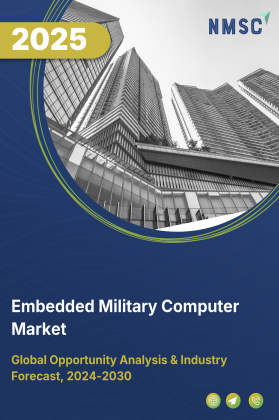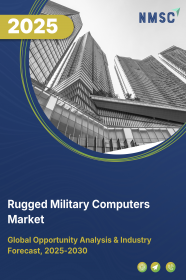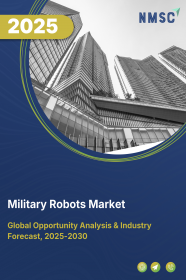
Embedded Military Computer Market by Components (Processing Units, Memory and Storage), by System Type (Rugged Mission Computers, Modular Computing Systems), by Technology Generation (Legacy, Upgraded, Current), by Operational Criticality (Mission-Critical), by Deployment Scale (Mass-Deployed, Standard, General), by Application (Command and Control, Intelligence Gathering), and by End User (National Defense Organizations) – Global Opportunity Analysis and Industry Forecast 2025-2030.
Industry Outlook
The global Embedded Military Computer Market size was valued at USD 3.39 billion in 2024, with an estimation of USD 3.73 billion in 2025 and is predicted to reach USD 5.15 billion by 2030 with a CAGR of 6.62% from 2025-2030. The market is experiencing robust growth driven by increasing government investment in defense modernization, with budgets rising to support advanced technologies such as electronic warfare, unmanned systems, secure communications, and cyber defense.
Escalating geopolitical tensions in regions like Europe and the Indo-Pacific are further propelling demand for high-performance, rugged computing systems essential for command-and-control, surveillance, and mission-critical operations. Engineered for extreme environments, these computers offer reliability, shock resistance, and thermal protection, ensuring operational success.
While cybersecurity risks pose challenges, the integration of AI, IoT, and cloud platforms is creating significant opportunities by enhancing situational awareness, predictive analytics, and operational efficiency, supporting sustained embedded military computer market expansion.
Increasing Government Investment in Defense Modernization Boosts the Market Demand
Rising government spending on defense modernization is one of the strongest drivers for embedded military computer sales. According to the 2025 Future Years Defense Program (FYDP), the U.S. Department of Defense (DoD) budget is projected to reach $866 billion by 2029, reflecting a 1.9% increase from 2025 (when adjusted for inflation).
A significant portion of this investment is directed toward advanced technologies, including electronic warfare, unmanned systems, secure communications, and cyber defense, all of which rely on embedded military computing solutions. This steady increase in defense allocations underscores governments’ commitment to modernizing military infrastructure, thereby creating sustained demand for rugged and high-performance embedded computers.
Growing Geopolitical Tensions Fuel Market Growth
Escalating geopolitical tensions, particularly in Europe and the Indo-Pacific, are compelling nations to boost their defense capabilities, directly driving demand for embedded military computers that are essential for systems like command-and-control, surveillance, and electronic warfare.
For example, NATO Secretary-General Jens Stoltenberg announced that 23 of the 32 NATO member states met the 2% of GDP defense spending benchmark in 2024, setting a new record for commitment to military preparedness. As countries prioritize technological superiority in response to security threats, the need for high-performance, rugged embedded computing systems continues to accelerate.
Enhanced Reliability and Ruggedness Drive Market Adoption
Military operations frequently unfold in extreme and unpredictable environments whether in scorching deserts, dense jungles, icy arctic zones, or marine settings. In such conditions, conventional computing systems fail, but tactical embedded systems are engineered with ruggedized designs, including shock resistance, thermal management, and protection against dust, moisture, and vibration.
Their proven ability to deliver consistent performance under mission-critical scenarios makes them a trusted choice for defense agencies. This reliability not only ensures operational success in high-stakes missions but also strengthens demand for embedded military computers, reinforcing their importance in global defense procurement.
Cybersecurity Risks Restrain the Market Growth
The rising risk of cyber threats poses a significant challenge to the embedded military computer market growth. Increasing interconnectivity of defense systems and reliance on advanced digital technologies make military operations vulnerable to data breaches, system intrusions, and cyberattacks.
Any compromise in security disrupts mission-critical operations and erode trust in these systems, thereby limiting their widespread adoption. Strengthening cybersecurity protocols and building resilient architectures remain essential to overcoming this restraint and sustaining market expansion.
Integration of AI, IoT, and Cloud Platforms Creates Opportunities for the Market
The growing integration of artificial intelligence (AI), machine learning (ML), IoT sensors, and cloud platforms presents promising opportunities for the embedded military computer market. These technologies enhance real-time decision-making, enable predictive analytics, and improve situational awareness in high-pressure environments.
By leveraging AI-driven automation and IoT-enabled data collection, military forces achieve greater operational efficiency and precision. This shift toward intelligent and connected defense ecosystems is expected to open new avenues for market growth in the coming years.
Market Segmentation and Scope of the Study
The market report is segmented by components, system type, technology generation, operational criticality, deployment scale, application, end user and region. Components include processing units, memory and storage, input/output interfaces, power supplies, cooling mechanisms, enclosures, backplanes, signal processors, data converters, and timing modules. System types cover rugged mission computers, modular systems, vehicle-mounted and soldier-worn computers, avionics, naval, space-qualified, electronic warfare, and unmanned system controllers. Regional analysis covers Asia-Pacific, North America, Europe, and Rest of the World (RoW).
Geographical Analysis
North America holds the largest embedded military computer market share, supported by the region’s robust defense sector and continuous focus on modernization programs. The Aerospace Industries Association reported that the U.S. aerospace and defense sector reached USD 955 billion in 2023, marking a 7.1% increase from 2022. This steady expansion drives significant investments in advanced technologies, boosting the adoption of embedded military computers to meet the growing demands of modern warfare, real-time operations, and enhanced battlefield communication systems.
Europe is poised to see notable growth in the embedded military computer market, supported by strong EU-led initiatives aimed at strengthening defense capabilities and fostering technological innovation. Under the EU budget, approximately USD 9.6 billion has been allocated to the European Defence Fund to advance defense research and development, while around USD 1.9 billion supports military mobility projects through the Connecting Europe Facility.
In addition, nearly USD 327 million has been earmarked for joint defense procurement and about USD 545 million to scale up ammunition production. Furthermore, in June 2025, the Council adopted its mandate for negotiations with the European Parliament on the European Defence Industry Programme (EDIP), which will provide nearly USD 1.64 billion in grants by 2027. These investments highlight Europe’s commitment to modernizing its defense ecosystem, which in turn is expected to accelerate the adoption of embedded military computers for applications in advanced platforms, secure communication, surveillance, and mission-critical operations.
The Asia-Pacific region is projected to experience steady growth in the embedded military computer market over the forecast period, driven by rising defense capabilities and the growing adoption of modern technologies to enhance communication, intelligence, surveillance, and operational efficiency.
According to the Ministry of Commerce and Industry (2024), India’s defense manufacturing sector recorded production worth USD 12.82 billion and exports of USD 1.36 billion in 2023. As defense manufacturers in the region expand capacity to address increasing security demands, the adoption of defense electronics is accelerating, as these systems provide the advanced computing power necessary for next-generation defense platforms and mission-critical applications.
The Rest of the World (RoW), encompassing the Middle East, Africa, and Latin America, is emerging as a promising market for embedded military computers. Heightened geopolitical tensions, regional conflicts, and evolving security threats are driving governments in these regions to strengthen defense infrastructure and adopt advanced technologies.
Investments in modern warfare systems, surveillance networks, and border security solutions are creating opportunities for the integration of embedded military computers. These systems are increasingly being deployed to enhance situational awareness, support real-time decision-making, and ensure the efficiency of mission-critical defense operations, thereby fueling the embedded military computer market growth across RoW.
Strategic Innovations Adopted by Key Players
Key players in the embedded military computer industry are strengthening their global presence through product innovation, advanced technology integration, and strategic contract wins.
-
In June 2025, General Dynamics Information Technology (GDIT) was awarded a contract to enhance operational effectiveness for Special Operations Forces using AI, cloud, and cyber capabilities.
-
In February 2025, Crystal Group debuted next-generation rugged embedded computers at AFCEA WEST 2025, designed for high-performance edge computing in defense applications.
-
In March 2024, ADLINK Technology introduced new open standard modules and edge computing platforms at Embedded World 2024, focusing on Edge AI innovations.
Key Benefits
-
The report provides quantitative analysis and estimations of the industry from 2025 to 2030, that assists in identifying the prevailing embedded military computer market opportunities.
-
The study comprises a deep-dive analysis of the current and future embedded military computer market trends to depict prevalent investment pockets in the sector.
-
Information related to key drivers, restraints, and opportunities and their impact on the market is provided in the report.
-
Competitive analysis of the key players, along with their market share is provided in the report.
-
SWOT analysis and Porters Five Forces model is elaborated in the embedded military computer market study.
-
Value chain analysis in the market study provides a clear picture of roles of stakeholders
Embedded Military Computer Market Key Segments
By Components
-
Processing Units
-
Memory and Storage
-
Input and Output Interfaces
-
Power Supply Systems
-
Cooling Mechanisms
-
Enclosures and Chassis
-
Backplanes and Interconnects
-
Signal Processors
-
Data Converters
-
Timing and Synchronization Modules
-
Others
By System Type
-
Rugged Mission Computers
-
Modular Computing Systems
-
Vehicle Mounted Computers
-
Soldier Worn Systems
-
Avionics Computers
-
Naval Combat Systems
-
Space Qualified Computers
-
Electronic Warfare Systems
-
Unmanned System Controllers
-
Others
By Technology Generation
-
Legacy Systems
-
Upgraded Systems
-
Current Systems
-
Next Generation Systems
-
Prototype Systems
-
Experimental Systems
-
Field Tested Systems
-
Production Systems
-
Custom Systems
-
Others
By Operational Criticality
-
Mission Critical Systems
-
Safety Systems
-
High Availability Systems
-
Support Systems
-
Auxiliary Systems
-
Non-Critical Systems
-
Others
By Deployment Scale
-
Mass Deployed Systems
-
Standard Systems
-
General Systems
-
Platform Systems
-
Theater Systems
-
Specialized Systems
-
Niche Systems
-
Limited Systems
-
Custom Systems
-
Prototype Systems
-
Portable Field Computers
-
Others
By Application
-
Command and Control Systems
-
Intelligence Gathering Systems
-
Surveillance Systems
-
Reconnaissance Systems
-
Weapon Guidance Systems
-
Electronic Warfare Systems
-
Navigation Systems
-
Target Acquisition Systems
-
Training Systems
-
Communication Systems
-
Others
By End User
-
National Defense Organizations
-
Army Forces
-
Navy Forces
-
Air Forces
-
Space Forces
-
Defense Contractors
-
Government Security Agencies
-
Research Laboratories
-
Homeland Security Units
-
Allied Military Forces
-
Others
By Region
-
North America
-
The U.S
-
Canada
-
Mexico
-
Europe
-
The UK
-
Germany
-
France
-
Italy
-
Spain
-
Denmark
-
Netherlands
-
Finland
-
Sweden
-
Norway
-
Russia
-
Rest of Europe
-
Asia-Pacific
-
China
-
Japan
-
India
-
South Korea
-
Australia
-
Indonesia
-
Singapore
-
Taiwan
-
Thailand
-
Rest of Asia-Pacific
-
Rest of the World
-
Latin America
-
Middle East
-
Africa
Key Players
-
Mercury Systems, Inc.
-
General Dynamics Mission Systems
-
BAE Systems
-
Teledyne Technologies Incorporated
-
ADLINK Technology Inc.
-
Crystal Group Inc.
-
Kontron AG
-
Aitech Defense Systems
-
MilDef Group AB
-
Getac Technology Corp.
-
Concurrent Technologies
-
Trenton Systems
-
Rheinmetall AG
Report Scope and Segmentation
|
Parameters |
Details |
|
Market Size in 2025 |
USD 3.73 Billion |
|
Revenue Forecast in 2030 |
USD 5.15 Billion |
|
Growth Rate |
CAGR of 6.62% from 2025 to 2030 |
|
Analysis Period |
2024–2030 |
|
Base Year Considered |
2024 |
|
Forecast Period |
2025–2030 |
|
Market Size Estimation |
Billion (USD) |
|
Growth Factors |
|
|
Countries Covered |
28 |
|
Companies Profiled |
15 |
|
Market Share |
Available for 10 companies |
|
Customization Scope |
Free customization (equivalent to up to 80 working hours of analysts) after purchase. Addition or alteration to country, regional, and segment scope. |
|
Pricing and Purchase Options |
Avail customized purchase options to meet your exact research needs. |

















 Speak to Our Analyst
Speak to Our Analyst

























